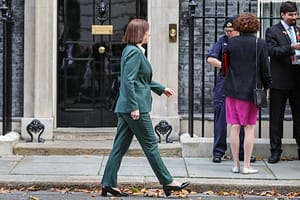As speculation about a snap spring general election looms following Jeremy Hunt’s autumn statement—with Labour currently 20 points ahead in the polls—the Office for Budget Responsibility (OBR) has predicted that local authorities will have to draw down £2.3bn of reserves over the next two years.
The estimated costs of inflation in 2022/23 for 40 of England’s largest councils has risen by 92% in just three months since they set their budgets in March. With this in mind, the SEO agency Reboot Online sought to uncover the impact of rising inflation and the cost of living crisis on spending in local constituencies across the United Kingdom.
To do so, budget and spending data from the Independent Parliamentary Standards Authority (IPSA) from 2016 to 2021 was analysed. Total spending data was forecasted for the years 2022-2024 using a linear model based on historical data and then adjusted to Consumer Price Index (CPI) inflation.
This provides a statistical foundation for understanding how local government spending has been impacted by recent economic pressures, and determining which constituencies are most affected.
SEO agency Reboot Online can reveal that Brentwood and Ongar (Essex) is projected to undergo the most substantial spending cuts in 2023, with an anticipated decrease of 18% compared to 2021 spending data.
This is a significant decrease in spending compared to the neighbouring constituency of Epping Forest, which is forecasted to experience a spending increase of around 57% between 2021 and 2023. Total spending data was forecasted using a simple linear model based on previous yearly data. To account for the cost of living crisis and changes in real terms, all total spending figures were adjusted for CPI inflation using a combination of OECD rates and forecasted rates.
Ayr, Carrick and Cumnock, a constituency in Scotland, are also expected to see a reduction in total spending of over 16% between 2021 and 2023. In Gordon — another Scottish constituency — there is predicted to be a 13.45% cut in 2023 spending compared to 2021 figures, which may be attributed to the Consumer Price Index rising from 2.5 to 6.9.
Gordon’s spending is predicted to decrease significantly from £246,596 to £213,423 (-13.45%) between 2021-2023. This is a staggering difference compared to the neighbouring constituency of West Aberdeenshire and Kincardine, which is projected to see a 14.05% increase in spending in 2023 compared to 2021.
The regions that may be hit hardest by inflation-adjusted spending cuts
With Ayr, Carrick and Cumnock and Gordon ranking among the top three constituencies expected to face the most significant spending cuts, residents in Scotland may be among the hardest hit by local government spending cuts.
Additionally, constituencies in the North West and South West of England could also be heavily affected, accounting for four out of the eight most affected constituencies. Rochdale in Greater Manchester is expected to experience the most substantial reduction in spending in the North West, with spending forecasted to decrease from £252,031 in 2021 to £228,148 in 2023 (-9.48%).
Similarly, Kingswood (South Gloucestershire) is also expected to experience a substantial spending decrease of 11.10%, going from £160,458 in 2021 to £139,928 in 2023, making it the most significant decrease in the South West.
SEO agency Reboot Online’s study uncovered that Swansea West is forecasted to see a 60% increase in spending between 2021 and 2023. This is a significant increase in projected spending compared to the bordering constituency, Swansea East where there is a forecasted spend increase of just 8.64% between 2021 and 2023.
Similarly, Kettering, in Northamptonshire is predicted to be among the least affected constituencies by local government spending cuts as 2023 spending is projected to have increased by 59.22% from 2021.
Walthamstow is the third constituency that is expected to experience substantial increases in spending, despite rising inflation rates and the cost of living crisis. Projected spending in Walthamstow in 2023 is 57.34% higher than the spending in 2021. This contrast is significant when compared to the neighbouring constituency of Tottenham, where the projected spending increase is only 13.99% — considerably less than Walthamstow.
The constituencies expected to maintain their spending
While some constituencies are projected to maintain their spending at the same level from 2021 to 2022, they are, in effect, spending less when accounting for rising inflation rates.
Leeds Central, Barnsley East and Neath are among the 12 constituencies projected to experience an increase in spending of less than 1%. However, in 2023, the inflation rate soared to as high as 7.9%. With this in mind, it is estimated that local government spending in these areas will appear significantly lower.






Leave a Comment